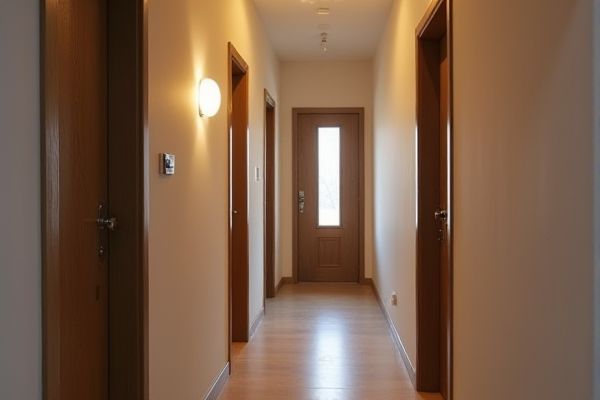
Smart entry lights offer convenient, automatic illumination triggered by motion sensors or smartphone control, enhancing security and energy efficiency compared to manual hallway lights that require physical switches. Discover how upgrading to smart lighting can transform Your home's functionality and comfort by reading the rest of this article.
Table of Comparison
| Feature | Smart Entry Light | Manual Hallway Light |
|---|---|---|
| Operation | Automatic sensor or app-controlled | Switch-based manual control |
| Energy Efficiency | High; auto off/on with motion detection | Low; depends on user switching off |
| Convenience | Hands-free entry, adaptive lighting | Requires manual activation |
| Installation | Requires smart sensor and network setup | Simple electrical wiring |
| Cost | Higher initial investment | Lower initial cost |
| Maintenance | Software updates and occasional sensor calibration | Minimal; bulb replacement |
| Lighting Control | Customizable via app or voice | Fixed light settings |
| Security | Enhances safety with automatic illumination | Limited; depends on user activation |
Introduction to Entry Lighting Solutions
Smart entry lights offer automated control, motion detection, and energy efficiency, enhancing convenience and security compared to manual hallway lights that require physical interaction to operate. These intelligent systems can adjust brightness based on ambient light and occupancy patterns, ensuring optimal illumination when you enter a space. Choosing a smart entry light elevates your home's functionality by reducing energy waste and providing seamless lighting management tailored to your needs.
What is a Smart Entry Light?
A smart entry light is an advanced lighting system integrated with sensors and automation technology, enabling it to detect motion and ambient light levels to illuminate entryways automatically. Unlike manual hallway lights, smart entry lights enhance convenience, security, and energy efficiency by activating only when needed. These lights often feature connectivity with smart home systems, allowing remote control and customization through mobile apps or voice commands.
Understanding Manual Hallway Lights
Manual hallway lights require you to physically toggle switches to illuminate your space, often leading to forgotten lights and increased energy consumption. These traditional systems lack sensors or automation, making it necessary for you to remember to turn them off, which can be inconvenient in busy households. Understanding manual hallway lights highlights the contrast with smart entry lights that automatically activate and optimize energy use.
Key Features of Smart Entry Lights
Smart entry lights offer motion sensors, automatic activation, and energy-efficient LED technology, enhancing convenience and security at entryways. These lights often include customizable settings such as adjustable brightness, color temperature, and scheduled timers, providing tailored illumination. Integration with smart home systems allows remote control and real-time monitoring, surpassing the manual hallway light's static on/off function.
Installation Process: Smart vs. Manual Lights
Smart entry lights typically require a more complex installation process involving wiring integration with home automation systems, Wi-Fi connectivity setup, and app configuration. In contrast, manual hallway lights feature straightforward wiring to existing circuits, enabling quick installation without the need for network or software adjustments. The smart light installation demands technical knowledge or professional assistance, while manual lights can often be installed by DIY homeowners.
Energy Efficiency Comparison
Smart entry lights use motion sensors and LED technology to optimize energy consumption by activating only when movement is detected, significantly reducing wasted electricity compared to manual hallway lights that often remain on unnecessarily. Manual hallway lights typically rely on constant use or manual switches, leading to higher energy usage and increased electricity costs. Integrating smart systems with energy-efficient bulbs can cut energy consumption by up to 70%, enhancing sustainability and lowering utility bills.
Convenience and Accessibility
Smart entry lights provide unparalleled convenience by allowing you to control lighting through voice commands, smartphone apps, or motion sensors, eliminating the need to manually flip switches. These lights enhance accessibility by automatically illuminating hallways when motion is detected, ensuring safe navigation even with full hands or limited mobility. Manual hallway lights require physical interaction, which can be less practical in dark or busy environments where immediate lighting is essential.
Cost Analysis: Upfront and Long-Term
Smart entry lights typically have a higher upfront cost due to advanced sensors and connectivity features, while manual hallway lights require less initial investment. Over time, smart lights can reduce energy expenses through automated controls and adaptive brightness, potentially lowering your utility bills compared to manual systems. Considering both installation and operational costs, smart entry lights offer a cost-effective solution for long-term savings despite the initial premium.
Security Benefits of Smart Entry Lights
Smart entry lights enhance security by automatically illuminating pathways when motion is detected, deterring potential intruders more effectively than manual hallway lights that rely on user activation. These intelligent lighting systems often integrate with security cameras and alarm systems, providing real-time alerts and improved visibility during nighttime. Unlike manual lights, smart entry lights reduce the risk of dark areas vulnerable to break-ins, significantly increasing home safety.
Which Entry Light is Right for You?
Smart entry lights offer automated lighting with motion sensors and remote control, enhancing convenience and energy efficiency in your hallway. Manual hallway lights require physical switches but provide straightforward operation without dependence on connectivity or batteries. Your choice depends on preferences for technology integration, ease of use, and energy savings in your home.
 homyna.com
homyna.com